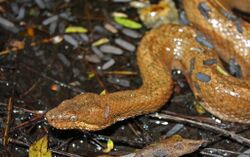Biology:Tropidophis
| Tropidophis | |
|---|---|

| |
| Tropidophis melanurus | |
| Scientific classification Error creating thumbnail: Unable to save thumbnail to destination
| |
| Domain: | Eukaryota |
| Kingdom: | Animalia |
| Phylum: | Chordata |
| Class: | Reptilia |
| Order: | Squamata |
| Suborder: | Serpentes |
| Family: | Tropidophiidae |
| Genus: | Tropidophis Bibron In de la Sagra, 1843 |
| Synonyms | |
| |
Tropidophis, common name Caribbean dwarf boas, wood snakes or West Indian wood snakes,[2] is a genus of dwarf boas[3] endemic to the West Indies and South America. Currently, either 17 or 33 species are recognized, depending on the authority.[3]
Description
Adults grow to between 30 and 60 cm (12 and 24 in) in total length (including tail). They are secretive and predominantly terrestrial, found in a variety of natural habitats, including rain forest, swamps, pine woods and scrub, as well as in the vicinity of human habitation. They have an interesting defensive habit of Autohaemorrhaging from the mouth, nostrils and eyes when disturbed.Cite error: Closing </ref> missing for <ref> tag
| Species[4] | Taxon author[4] | Subsp.*[4] | Common name | Geographic range[4] |
|---|---|---|---|---|
| Tropidophis cacuangoae | (Hedges, Estrada & Díaz, 1999) | 0 | Ecuador | |
| Tropidophis celiae | (Hedges, Estrada & Díaz, 1999) | 0 | Canasi dwarf boa | Cuba and adjacent islands |
| Tropidophis curtus | (Garman, 1887) | 0 | Northern Bahamas dwarf boa | the Bahamas |
| Tropidophis galacelidus | Schwartz & Garrido, 1975 | 0 | Escambray white-necked dwarf boa | central Cuba |
| Tropidophis grapiuna | Curcio, Sales-Nunes, Suzart-Argolo, Skuk & Rodrigues, 2012 | 0 | Brazil | |
| Tropidophis hardyi | Schwartz & Garrido, 1975 | 0 | Escambray small-headed dwarf boa | Cuba |
| Tropidophis hendersoni | Hedges & Garrido, 2002 | 0 | Cuban khaki dwarf boa | Cuba |
| Tropidophis jamaicensis | Stull, 1928 | 0 | Jamaican dwarf boa | Jamaica |
| Tropidophis leonae | Landestoy, 2023 | 0 | Jaragua golden trope | Dominican Republic |
| Tropidophis morenoi | Hedges, Garrido & Díaz, 2001 | 0 | zebra dwarf boa | Cuba |
| Tropidophis parkeri | Grant, 1941 | 0 | Parker's dwarf boa[5] | Little Cayman Island |
| Tropidophis preciosus | Curcio, Sales Nunes, Suzart Argolo, Skuk & Rodrigues, 2012 | 0 | Brazil | |
| Tropidophis schwartzi | Thomas, 1963 | 0 | Schwartz's dwarf boa[5] | the Cayman Islands |
| Tropidophis spiritus | Hedges & Garrido, 1999 | 0 | Sancti Spíritus dwarf boa | Cuba |
| Tropidophis steinleini | Díaz & Cádiz, 2020 | 0 | Cuba | |
| Tropidophis stejnegeri | Grant, 1940 | 0 | Stejneger's dwarf boa | northern Jamaica |
| Tropidophis stullae | Grant, 1940 | 0 | Stull's dwarf boa | southern Jamaica |
| Tropidophis xanthogaster | Domínguez, Moreno & Hedges, 2006 | 0 | Guanahacabibes dwarf boa | Cuba |
- ) Not including the nominate subspecies.
There are currently 33 species, in which 26 of them are West Indian and 15 of them are Cuban. The 15 species in Cuba are the most diverse.[6]
References
- ↑ McDiarmid RW, Campbell JA, Touré TA (1999). Snake Species of the World: A Taxonomic and Geographic Reference, Volume 1. Washington, District of Columbia: Herpetologists' League. 511 pp. ISBN:1-893777-00-6 (series). ISBN:1-893777-01-4 (volume).
- ↑ Parker HW, Grandison AGC (1977). Snakes — a Natural History. Second Edition. London and Ithaca: British Museum (Natural History) and Cornell University Press. 108 pp. + 16 plates. LCCCN 76-54625. ISBN:0-8014-1095-9 (cloth), ISBN:0-8014-9164-9 (paper).
- ↑ 3.0 3.1 "Tropidophis ". Integrated Taxonomic Information System. https://www.itis.gov/servlet/SingleRpt/SingleRpt?search_topic=TSN&search_value=174332. Retrieved 29 August 2007.
- ↑ 4.0 4.1 4.2 4.3 Cite error: Invalid
<ref>tag; no text was provided for refs namedRDB - ↑ 5.0 5.1 Beolens, Bo; Watkins, Michael; Grayson, Michael (2011). The Eponym Dictionary of Reptiles. Baltimore: Johns Hopkins University Press. xiii + 296 pp. ISBN:978-1-4214-0135-5. (Tropidophis parkeri, p. 200; T. schwartzi, p. 239).
- ↑ Hedges, S. Blair (November 2002). "Morphological variation and the definition of species in the snake genus Tropidophis (Serpentes, Tropidophiidae)" (in en). Bulletin of the Natural History Museum, Zoology Series 68 (2): 83–90. doi:10.1017/S0968047002000092. ISSN 1475-2980. https://www.cambridge.org/core/journals/bulletin-of-the-natural-history-museum-zoology-series/article/abs/morphological-variation-and-the-definition-of-species-in-the-snake-genus-tropidophis-serpentes-tropidophiidae/7E037EC6FFE65A8F19025F58A636A530.
Further reading
- Bibron G (1843). In: de la Sagra R (1843). Historia fisica, politica y natural de la isla de Cuba. Segunda parte historia natural. Tomo IV. Reptiles y peces. Paris: Bertrand. 255 pp. + Plates I-V. (Tropidophis, new genus, p. 124). (in Spanish).
- Boulenger GA (1893). Catalogue of the Snakes in the British Museum (Natural History). Volume I., Containing the Families ... Boidæ ... London: Trustees of the British Museum (Natural History). (Taylor and Francis, printers). xiii + 448 pp. + Plates I-XXVIII. (Genus Ungalia [=Tropidophis], p. 110).
- Freiberg M (1982). Snakes of South America. Hong Kong: T.F.H. Publications. 189 pp. ISBN:0-87666-912-7. (Genus Tropidophis, pp. 44, 80, 88, 188).
- Schwartz A, Thomas R (1975). A Check-list of West Indian Amphibians and Reptiles. Carnegie Museum of Natural History Special Publication No. 1. Pittsburgh, Pennsylvania: Carnegie Museum of Natural History. 216 pp. (12 species of Tropidophis, pp. 191–196).
External links
- Tropidophis at the Reptarium.cz Reptile Database. Accessed 29 August 2007.
Wikidata ☰ Q2692350 entry
 |

